We're sorry. An error has occurred
Please cancel or retry.
Genomic selection, gene editing and genetic engineering for drought tolerance in cereals
Regular price
£25.00
Sale price
£25.00
Regular price
£25.00
Unit price
/
per
Sale
Sold out
Re-stocking soon
This chapter provides the state of the art on genomic prediction of estimated breeding values (GEBV) for selection (or genomic selection) as well as on the use of genetic engineering for both gene ...
Read More

Some error occured while loading the Quick View. Please close the Quick View and try reloading the page.
Couldn't load pickup availability
- Format:
-
26 December 2022

This chapter provides the state of the art on genomic prediction of estimated breeding values (GEBV) for selection (or genomic selection) as well as on the use of genetic engineering for both gene editing and transgenic breeding in main cereals crops. Genomic selection has been successfully used for breeding maize in drought-prone sites of Africa and Asia, while progress was noted for using GEBV for improving pearl millet, rice, sorghum and wheat germplasm. Transgenic maize-derived hybrids were released about one decade ago for growing in the US Corn Belt, and there are available transgenic rice and wheat germplasm though not yet released as new cultivars. Gene editing shows promising results for maize while research advances are noted in both rice and wheat. Combining genomic selection and gene editing may further elevate genetic gains while improving cereals crops for drought-prone environments elsewhere.

Price: £25.00
Publisher: Burleigh Dodds Science Publishing
Imprint: Burleigh Dodds Science Publishing
Series: Burleigh Dodds Series in Agricultural Science
Publication Date:
26 December 2022
ISBN: 9781801466790
Format: eBook
BISACs:
TECHNOLOGY & ENGINEERING / Agriculture / Sustainable Agriculture, Sustainable agriculture, TECHNOLOGY & ENGINEERING / Agriculture / Agronomy / Crop Science, Agronomy and crop production, Agricultural science

1 Introduction 2 Genomic estimated breeding values for selection 3 Genetic engineering 4 Conclusion 5 Where to look for further information 6 References



